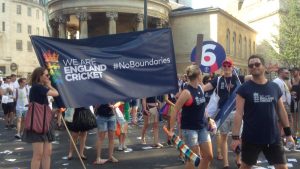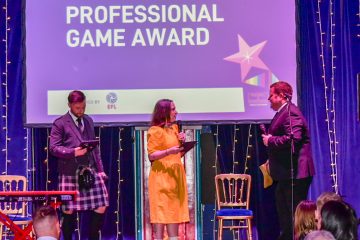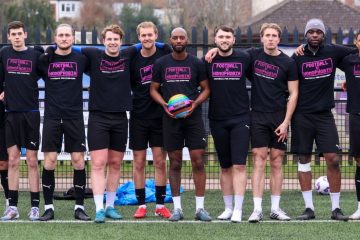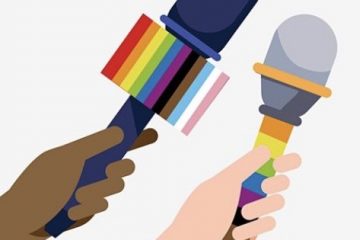What did we learn from the Rainbow Laces Summit?

Jon Holmes looks back at Stonewall’s Rainbow Laces Summit from a media perspective, and identifies five key points made on LGBT+ inclusion in sport…
Over 200 attendees from across the world of sport were at Wembley Stadium on September 14 for LGBT charity Stonewall’s Rainbow Laces Summit.
The campaign for inclusion in sport for people who are lesbian, gay, bisexual or transgender was originally launched in 2013, and continues to grow in support and recognition; last year, over 12 million adults in Britain saw Rainbow Laces during the activation period in November and December. Following this increase in visibility, Stonewall and TeamPride – the coalition of businesses and brands that helps to amplify the inclusion message – won the Campaign of the Year gong for Rainbow Laces at the prestigious Sport Industry Awards back in April.
At one point on the day of the Summit, #RainbowLaces was even trending in the UK at the number two slot on Twitter…
???? pic.twitter.com/TBJzvIcG36
— Jay Lemonius (@JayDot90) September 14, 2018
However, that wasn’t reflected in the day’s national sports news agenda. An LGBT social group in Kent reflected on this in a tweet on Monday night…
I wish there was more coverage of @stonewalluk #rainbowlaces campaign in the mainstream media. Such an important cause to publicize @BBC @ITV @Channel4News https://t.co/ZBpfukBig7
— CanterburyGayGuys (@CanterburyGay) September 17, 2018
There was coverage on Sky Sports (who I work for) – but that’s a no-brainer, given the company is one of the members of TeamPride. Our Sky Sports News reporter Geraint Hughes was working at Wembley on the day, and interviewed Stonewall’s Director of Sport Kirsty Clarke, athlete Tom Bosworth, and football referee Ryan Atkin on air. Atkin’s interview also ran on our website.
However, there wasn’t (at the time of writing) any pick-up from elsewhere in the mainstream media. So in our role here at Sports Media LGBT+ of trying to keep our part of the industry informed of such things, here’s a quick rundown of some of the main talking points of the day…
LGBT people in sport – though still rarely visible – are driving inclusion, along with allies
If you’re LGBT, you don’t even have to be ‘out’ to help get inclusion on the agenda in your sport, although being open and your authentic self remains the best way to raise awareness. A workplace survey, which can be submitted anonymously and which gleans honest responses from all its employees, will speak to the culture of the whole organisation. The Football Association, hosts for the Summit, are a great example of this…
Martin Glenn, chief executive of the @FA, explains how internal data that showed 7% of FA staff and 6% of county FA staff identified as LGBT+ has helped to drive the association’s inclusion work. #RainbowLaces #RainbowLacesSummit pic.twitter.com/KzfL6iSB0n
— Sports Media LGBT+ (@SportsMediaLGBT) 14 September 2018
 The significance of the England and Wales Cricket Board’s landmark participation as a national governing body (NGB) in the Pride in London parade in July should not be underestimated, particularly when taken in conjunction with the second annual activation of Rainbow Stumps in the sport later that same month. This was all achieved by LGBT people in cricket joining with allies with a shared willingness to do more and, in the words of ECB People Director Rosie Ranganathan, make the sport “as welcome and accessible as possible”.
The significance of the England and Wales Cricket Board’s landmark participation as a national governing body (NGB) in the Pride in London parade in July should not be underestimated, particularly when taken in conjunction with the second annual activation of Rainbow Stumps in the sport later that same month. This was all achieved by LGBT people in cricket joining with allies with a shared willingness to do more and, in the words of ECB People Director Rosie Ranganathan, make the sport “as welcome and accessible as possible”.
And as the Premier League have shown through their partnership with Stonewall, you can make a commitment to inclusion with vocal allies leading the way – you don’t have to wait for an LGBT employee to be the one to instigate greater inclusion. Meanwhile, for those LGBT people that do grasp the nettle, the results can be hugely energising… Charlie Martin asked her colleagues in motorsport to support Pride month by adding rainbow stickers to their cars on a race weekend at Silverstone, eliciting a superb response.
Why is this worthwhile? As Tom Bosworth explained in his presentation, it’s all with a view to removing any unease or uncertainty for an LGBT person who – if there’s little to no mention of inclusion in their sport – can’t be sure of finding acceptance. It might sound to some like a trifling thing, but as we know, it makes a big difference to the individual…
Olympian @TomBosworth says holding on to a worry weighs you down in sport which is why inclusive sporting environments are so important. They allow people to be themselves and achieve their potential in sport – as in the workplace and as in life. #RainbowLaces #ComeOutForLGBT pic.twitter.com/KZp2gpDZDe
— Darren Towers (@happyecologist) 14 September 2018
‘Active allies’ give others confidence to join the conversation
There’s still a sense of caution for many individuals in sport when the acronym ‘LGBT’ is mentioned. If you’re lesbian, gay, bisexual or trans, you might feel like you’re the only one in your immediate sporting environment, and that you don’t particularly want to draw attention to yourself. If you’re not LGBT, you may worry that your motivations for being a champion for inclusion will be questioned or scrutinised, or that you don’t necessarily feel educated enough to take on this particular cause.
That’s why, for those already on this journey, it’s so important that we try to empower others. At the Summit, there were many ‘active allies’ from various sports, all of whom spoke positively about the impact Rainbow Laces and inclusion have had on their organisations. By seeking out potential new allies and inviting them to learn more, we can help them overcome any initial trepidation and demonstrate why having a culture where everyone can be their authentic selves and flourish is good for all.
It’s particularly vital that we show how individuals who are transgender have been able to successfully access sport and benefit from that involvement. There are far too many irresponsible sweeping statements being made about trans inclusion; one negative incident is often used to make a series of generalisations. This means that every story which shows where trans people’s lives have been enriched by participation and acceptance in sport is so valuable. We believe these stories, these lived experiences, need to be reported and shared more frequently in the mainstream media. Racing driver Charlie Martin’s story, as told in her presentation, had a noticeable impact on the audience…
“Transitioning in motorsport was scary. I nearly left the sport I love more than anything.” — racing driver @GoCharlieM speaks powerfully about her journey, the importance of support, inclusion and visibility, and why we should all #ComeOutForTransEquality in sport. #RainbowLaces pic.twitter.com/bqhtRYnXoP
— Stonewall (@stonewalluk) 14 September 2018
Natalie Washington, a forward for Rushmoor FC in Farnborough who contributed to the Summit’s ‘grassroots sport’ panel, explained how her club made the effort to ensure she was included…
Great panel on developing welcoming spaces for members of the LGBTQ+ community, calling on NGBs to publicise their support & regs widely.
For Natalie the most important thing was being welcomed and assured that the club would work with her to get the regs sorted.#rainbowlaces pic.twitter.com/OJL0T5nFG2
— Dave Haggart (@dahaggart) September 14, 2018
Take time to gain an insight on intersectionality
As this ‘LGBT myth buster’ article from Stonewall’s website explains, “it’s important to understand the idea of ‘intersectionality’ – a term which describes how someone can suffer lots of different types of discrimination just because their identity overlaps several minority groups, like race, class, gender, age, ethnicity, health and so on.”
Too often, the LGBT experience in sport is ‘boiled down’ to only one facet – the gay man in professional football, the trans woman who wants to compete, the lesbian rugby player, etc. What extra pressures are there for someone who’s LGBT and also from the BAME community, or has a disability, or has come out in later life?
One of the panellists in the Summit’s final session was Amazin LeThi, who founded the anti-bullying campaign Act To Change and also her own Foundation charity. Her personal journey led her to channel her energies into sports and fitness during a difficult time in her life. She later became the first Athlete Ally ambassador from the Asian community and told their website…
To be an openly out… Asian athlete means coming out to your family and community, and the intersection of sexuality and cultural identity in a conformist society weighs heavily on rainbow Asian people in this process. The fear is that being open about your sexuality or gender identity/expression will shame or dishonour your family, with great disappointment that you’ve not lived up to the expectation your family has of you.
LeThi cited a story from the preceding days of the Summit of Tadd Fujikawa, born in Hawaii of Japanese parentage, writing openly on social media about being a gay man in professional golf. It’s an example that shows we need to be more mindful of intersectionality and give greater consideration to those unique experiences.
And one more thought… this Sunday (September 23) is Bi Visibility Day, yet there are hardly any ‘out’ bi people in sport, even though “self-identified bisexuals make up the largest single population within the LGBT community” (San Francisco Human Rights Commission, 2011) and a 2015 YouGov survey showed more than 40% of people exhibit bi behaviours or are attracted to more than one gender. Do bisexual people feel overlooked, or even erased, when it comes to sport?
Closing panel at #RainbowLaces Summit – @TomBosworth @amazinlethi @ryantatkin @GoCharlieM. Amazin discussing intersectionality, and how Asian LGBT youth simply don’t see themselves represented in sport at the moment. @Tadd_Fujikawa’s story this week a rare but inspiring example. pic.twitter.com/WVV9spYFGq
— Sports Media LGBT+ (@SportsMediaLGBT) 14 September 2018
When will a Premier League player come out? When the stars align…
It’s almost three years since Tom Bosworth sat down for an interview with the BBC’s Victoria Derbyshire and spoke openly about his sexuality. He was 25 at the time and the question he’s probably been asked the most since then hasn’t even been about him. As much as we love athletics when the Olympics rolls around every four years, it’s football that hogs the headlines, and tends to dominate any British conversation about being gay in sport.
Tom now has a simple, realistic response when asked for his thoughts on why gay footballers won’t come out publicly – it’s likely that the pillars of security for those players aren’t in place. Do they have the full strength of support from their family and friends, their team-mates, their sponsors, their coaches… do they have a loving partner? If any of those things are missing, chances are they’re not going to feel emboldened enough to share that part of their identity with the wider world.
As Ryan Atkin explained so well to Sky Sports News, that’s where Rainbow Laces comes in – it’s the underlying ‘off the pitch’ societal message of inclusion that the campaign carries, as well as the slogan ‘make sport everyone’s game’. The more allies we make, the more those pillars are strengthened for each LGBT person.
Great interview with Geraint Hughes today on @skysports @stonewalluk #rainbowlacessummit. What is your team, club or organisation doing to promote equality, inclusion and diversity in sports? ⚽️??⚾️???? #lgbt #sport #referee #football #cricket #rugby #tennis #hockey pic.twitter.com/G45G2TDLM8
— Ryan T Atkin (@ryantatkin) September 14, 2018
Let’s be clearer about what constitutes anti-LGBT language and behaviour
The panel session with representatives from sports governing bodies was one of the most fascinating at the Summit. One part of their presentations that really stood out for me was the ‘We Are Rugby Players: The Liverpool Tritons’ video from May 2017, screened by the RFU’s Rugby Growth Development Manager, Alex Teasdale.
‘The only daisies on this pitch are in the grass,’ says the video’s title text. Then, in even larger font, ‘CALL ME A FAG… QUEER… POOFTER…’ before an emphatic statement: ‘I AM A RUGBY PLAYER’. The short film has had over 5,500 views on Facebook, but I’d never seen it before. Could it have been seen more widely at the time? Was it the film’s bold, visual use of homophobic language that put people off from sharing it?
While words in isolation can cause offence, their meaning is ultimately judged by the context in which they are used. As Stonewall’s guidance for schools reminds us…
Words that individuals use or would use to describe themselves (e.g. gay, lesbian, bisexual, girl, black) are acceptable. Words or phrases that wrongly imply an individual’s membership of a group and/or refer to that particular group in a derogatory way are wrong (e.g. faggot, that’s so gay, you’re so gay).
Rather than refer to an “incident” or “gesture” that’s seen to be homophobic, or that anti-LGBT language has been used, should the media be more categorical about what happened or what was said, when a line has been crossed? It’s something of an editorial dilemma for journalists and editors, but it’s arguable that lesbian, gay, bi and trans people would be better served by further education for everyone around language, particularly with reference to gendered stereotypes in sport. Like the Tritons video demonstrates, tackling the problem head on tends to produce better results, as alluded to by inclusion expert Chris Gibbons…
Lots to take away from #RainbowLaces summit today. Encouraging to hear what's going on across the sport industry to include #LGBT people & tackle discrimination. Hope those of us working in the sector continue to share good practice & really #MakeSportEveryonesGame @stonewalluk
— Chris Gibbons (@gogibbogo) September 14, 2018
The Rainbow Laces campaign activation for 2018 will run from November 17 to December 7, with every Premier League and Premiership Rugby club set to have a home game during this period, and Autumn Internationals taking place in both football and rugby.
For more on the Summit, read this article by Dave Haggart – Corporate Fundraising Manager at WheelPower and the Wooden Spoon rugby charity – via LinkedIn.


